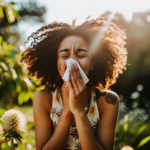Black Mold: The Facts
It’s possible you’ve heard of black mold in the past, particularly in a negative connotation. In fact, there are very few contexts in which mold, in general, is a good thing. Nevertheless, Black mold is quite common so it’s important to understand the risks
Black Mold – What To Look For
Black mold, also called toxic black mold, is a type of fungus that creates its conidium in black sludge. It can be found in dry soil and grain, although generally the black mold is most commonly detected in damp or moist building materials from water-or wet-mixed environments. This toxic black mold grows as a result of the breakdown of dead plant material (leaves, wood, and stems) that release spores into the air. Although black mold may not typically be seen in homes, it can still pose a threat to your health if you are allergic to mold or if you have an allergy to some form of mold.
Symptoms of exposure to toxic black mold range from shortness of breath and dizziness to memory loss, irritation of the eyes, nose, and throat, and nausea or vomiting. Because the symptoms of exposure to this microbial menace tend to occur in people who are already vulnerable to illness, the possibility of developing symptoms of exposure is higher than those who are healthy. In fact, symptoms can begin developing years before the onset of an actual mold infestation. Therefore, if you believe you may have been exposed to toxic black mold, it is important to document all the possible symptoms so that you can be properly diagnosed and receive the appropriate medical treatment.
Unfortunately, it is not always easy to determine whether or not you have been exposed to harmful black mold. Symptoms of exposure to this microscopic menace tend to develop slowly over time rather than all at once. Therefore, if you develop any of the following black mold symptoms, you may not actually have been exposed to the toxic molds yet. However, you may not wish to guess, and so it is always helpful to be able to document your symptoms in detail. Below are a few of the most common symptoms of exposure to toxic black mold:
Allergy patients are particularly prone to the dangers of black mold and its spores. If you believe that you or a family member has developed symptoms such as these, it is important to be able to document and obtain samples of their respiratory system for lab testing. Levels of bacteria and other allergens in the air can play a role in triggering an allergy attack. If you find your home’s humidity levels are substantially lower than the norm, especially during humidifier season, it is especially important to make sure that your allergy patients can have access to diagnostic testing equipment and a doctor who can confirm the existence of their particular allergies.
Mold remediation in the home is often necessary for persons who are exposed to toxic black mold. Unfortunately, not all homeowners are aware of the serious health effects associated with living in an environment that is rife with this toxic fungus. A typical procedure for black mold remediation involves removing the affected areas and disinfecting the site. If there are people in the house who are suffering from various health effects, it is likely that they will need to be relocated. While relocating may prove to be inconvenient, it is better than letting the disease progress.
Mold and mildew growth in the laundry room of a home or office is certainly a hazard. If you find that you, or someone else in the household, has developed symptoms such as these, it is crucial to ensure that you find a reputable company that specializes in black mold facts. These experts will conduct a number of tests to ascertain if you truly have a dangerous problem. If so, they will recommend solutions and provide information on how to prevent recurrences. It is imperative that the laundry room is properly ventilated, or the spores will spread to other parts of the home.
Other toxic black molds that pose a threat to health include those that produce mycotoxins. These mycotoxins can be produced by fungi, viruses, algae, and more. Mycotoxins are more commonly found in leaky pipes, roof leaks, roof shingles, and improperly treated basement water.
The most common symptom associated with mycotoxins is severe respiratory irritation. For this reason, remediation and treatment should be conducted promptly to avoid further escalation of the situation. Symptoms of severe respiratory illness include difficulty breathing, coughing, wheezing, and chest discomfort. The average incubation period for mycotoxins is one to two days, although the amount of time a person has to incubate depends upon several factors including the location of the mold spore, the degree of contamination, and the thickness of the contaminated area. In many cases, if a person suspects that he or she has contracted any type of black mold, it is critical to find and engage a company that specializes in mycotoxins to conduct all necessary testing and remediation.






